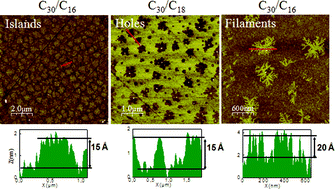Different types of phase separation in binary monolayers of long chain alkyltrichlorosilanes on silicon oxide†
Abstract
In the present work, we studied the growth and morphology of binary monolayers made with

* Corresponding authors
a Aix-Marseille Université, IM2NP
b CNRS, IM2NP
c
Institut Supérieur de l'Electronique et du Numérique, IM2NP Maison des Technologies, Place G. Pompidou, Toulon, France
E-mail:
lionel.patrone@im2np.fr
Fax: +33 494 038 951
Tel: +33 494 038 950
d Institute for Electronics, Microelectronics and Nanotechnology (IEMN), CNRS/University of Lille, Avenue Poincaré, BP 60069, Villeneuve d'Ascq, France
In the present work, we studied the growth and morphology of binary monolayers made with

 Please wait while we load your content...
Something went wrong. Try again?
Please wait while we load your content...
Something went wrong. Try again?
S. Desbief, L. Patrone, D. Goguenheim and D. Vuillaume, RSC Adv., 2012, 2, 3014 DOI: 10.1039/C2RA01327D
To request permission to reproduce material from this article, please go to the Copyright Clearance Center request page.
If you are an author contributing to an RSC publication, you do not need to request permission provided correct acknowledgement is given.
If you are the author of this article, you do not need to request permission to reproduce figures and diagrams provided correct acknowledgement is given. If you want to reproduce the whole article in a third-party publication (excluding your thesis/dissertation for which permission is not required) please go to the Copyright Clearance Center request page.
Read more about how to correctly acknowledge RSC content.
 Fetching data from CrossRef.
Fetching data from CrossRef.
This may take some time to load.
Loading related content
